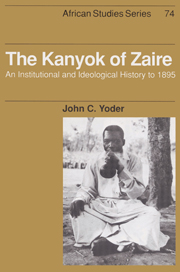Book contents
- Frontmatter
- Contents
- List of maps and figures
- Acknowledgments
- Abbreviations
- Chronology
- Introduction
- 1 Wood and wine, gardens and game
- 2 Stratification, symbols, and spirits
- 3 New legends for new leaders
- 4 Serpents and lightning
- 5 Dances, moats, and myths
- 6 Combat, classes, titles, and trade
- 7 Schisms and slaves, ghosts and guns
- 8 Assassinations, alliances, and ambushes
- APPENDIX: Methodology
- Notes
- Bibliography
- Index
- Titles in the series
8 - Assassinations, alliances, and ambushes
A failure of the feast, 1880 to 1895
Published online by Cambridge University Press: 29 September 2009
- Frontmatter
- Contents
- List of maps and figures
- Acknowledgments
- Abbreviations
- Chronology
- Introduction
- 1 Wood and wine, gardens and game
- 2 Stratification, symbols, and spirits
- 3 New legends for new leaders
- 4 Serpents and lightning
- 5 Dances, moats, and myths
- 6 Combat, classes, titles, and trade
- 7 Schisms and slaves, ghosts and guns
- 8 Assassinations, alliances, and ambushes
- APPENDIX: Methodology
- Notes
- Bibliography
- Index
- Titles in the series
Summary
The changes which Kasongo Cinyama, Cokwe raiders, and the Tungomb (Angolan traders) brought to Kasai in the 1870s had a profoundly destabilizing effect on Kanyok society. These outsiders, who were actually auxiliaries of Western merchants, Arab traders, or distant African chiefs, threatened to undermine the Kanyok government and society. In a land where the mid-century schism had already divided the state into separate eastern and western sections, village life became less secure, economic patterns less predictable, and political structures less stable. During these chaotic times, Mwen a Kanyok Kabw Muzemb struggled to give security and direction to the Kanyok state. A ruthless, tyrannical, and arrogant individual, and also a cunning, violent, and pitiless slave trader, Kabw Muzemb was able to control and use the era's predatory economic and military tactics to strengthen his own political position, to stabilize Kanyok government, and to protect Kanyok frontiers. (See Map 11.) While in the end an unequal match for the Congo Free State, he was, however, able to meet the lesser challenges from the Cokwe, Kasongo Cinyama, and the Tungomb.
Kabw Muzemb's rise to power
When Kasongo Cinyama fled to Etond in the late 1870s, he left Kanyok politics in turmoil. Although his puppet Ciband Musumb ruled at Mulundu, no one sat on the chief's chair at Katshisung. To add further confusion, as Kasongo Cinyama withdrew north to reestablish himself in the Gandajika area, he gave seven guns to Shimat a Ciband a Cilomb who hoped to take power at Katshisung.
- Type
- Chapter
- Information
- The Kanyok of ZaireAn Institutional and Ideological History to 1895, pp. 129 - 150Publisher: Cambridge University PressPrint publication year: 1992



